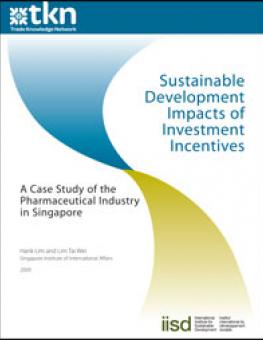
Sustainable Development Impacts of Investment Incentives: A Case Study of the Pharmaceutical Industry in Singapore
Summary:
In the mid-1960s Singapore threw its doors open to foreign investors, luring them with generous tax benefits and other investment incentives. More recently, the government has turned its attention to knowledge intensive industries in an effort to create employment, remain competitive in the face of rising wages and enable its own companies to move up the value chain. Investment incentives continue to play an important role in Singapore's strategy. This study examines whether the government's incentives to foreign investors - particularly financial incentives - have indeed helped to attract foreign investments and how these investments in turn have impacted employment creation, brought about economic diversification and generated spillover effects for the wider economy.
Key findings:
-
Since 2000 Singapore has invested over US$ 2 billion in the biomedical sciences (BMS) sector, including a second tranche of US$ 1 billion in 2006 to build up translational and clinical sciences capabilities. Much of the government's efforts to bolster R&D is centred on the multimillion dollar Biopolis hub.
By 2007 the pharmaceutical and biomedical sector had drawn in the largest share of FDI and pharmaceutical products had generated one of the highest returns within the manufacturing sector. This is a promising development, although it remains unclear whether these investment trends will be sustainable.
-
Between 2000 and 2007 employment in the biomedical sector almost doubled from 5,880 to 11,500 people. Over the next few years, the expansion of the BMS sector is predicted to contribute more than 5,000 jobs for engineers, scientists, technicians and corporate executives across manufacturing and R&D.
-
The type of employment created by the biomedical sector could bring additional spillovers, including the transfer of technologies and know-how to local entrepreneurs. However, in terms of absolute numbers, the sector has limited employment prospects compared to other manufacturing subsectors, especially electronics, whose decline the biomedial sector is meant to mitigate.
-
The stimuli to nudge Singapore in the biomedical direction are also present in other advanced ASEAN members such as Malaysia and Thailand. Singapore's experience shows that success in this competitive sector, and in particular with regard to biotechnology, can benefit from strong public administration and governance, effective institutions, infrastructure development, and clustering.
Key recommendations:
-
There is a danger that governments may provide too many incentives and actually reduce national welfare overall, a situation that is more likely when a multitude of governments are bidding for FDI. Thus, incentives should be part of a comprehensive industrial policy that may include support for domestic companies to enable them to take full advantage of technology spillovers.
-
To continue to invest and build on the basic BMS research capabilities in the Agency for Science Technology and Research and Singapore's universities, Singapore should focus on developing highly competitive programs in selected disease areas where the city state has comparative advantages, given the presence in its population of three Asian ethnic groups.
-
Progressive regional integration through ASEAN can also provide opportunities for Singapore to strengthen its biomedical sector, e.g. by easing investment flows in the recently created ASEAN Investment Area and increasing access to the fast growing ASEAN market.
You might also be interested in
Blackouts and Backsliding: Energy subsidies in South Africa 2023
Blackouts and Backsliding presents the latest energy subsidy data for South Africa.
Sustainable Asset Valuation of Parques del Río Norte in Medellín, Colombia
This economic valuation demonstrates the benefits of expanding urban green space in the city of Medellín, Colombia.
Progressing National SDGs Implementation
An independent assessment of the voluntary national review reports submitted to the United Nations High-level Political Forum on Sustainable Development in 2023.
A Sustainable Asset Valuation Assessment of Building and Transport Infrastructure Investment in the Shymkent-Tashkent-Khujand Economic Corridor
This report presents the Sustainable Asset Valuation (SAVi) of a proposed transport and building infrastructure development on the border of Kazakhstan and Uzbekistan to promote close and mutually beneficial trade relationships between the countries.